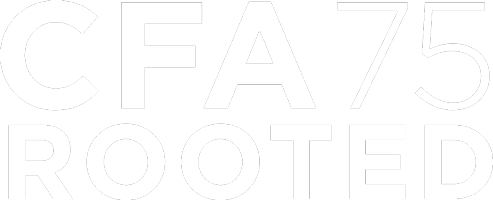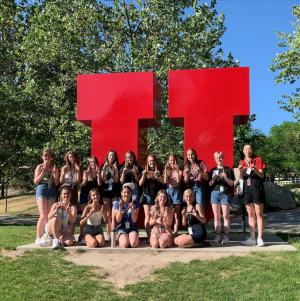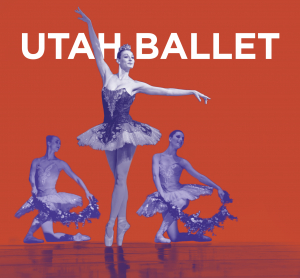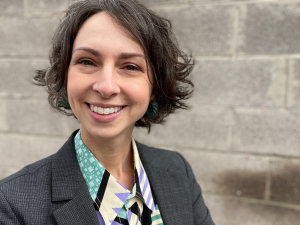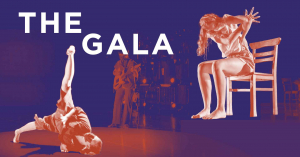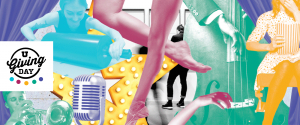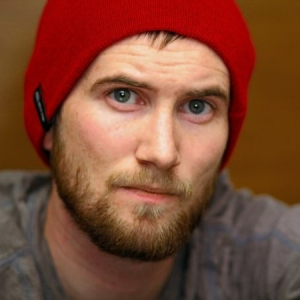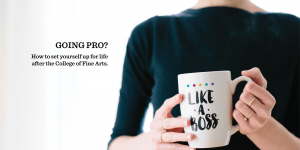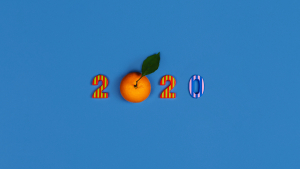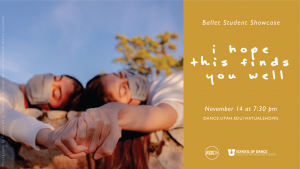Displaying items by tag: School of Dance
This Week, the School of Dance will kick off the annual Utah Ballet Summer Intensive (UBSI), which will be returning to an in person format for the first time since 2019. UBSI is 4 weeks of training aimed at sharpening dancer’s skills while immersing participants in a six-day a week program featuring classes offered by nationally and internationally renowned instructors. From June 21 to July 16, dancers will have a chance to learn from master teachers as well as U of U faculty and will gain insight into what life is like as a ballet major at the University of Utah. The dancers have been recruited on a national level, and include some first-year University of Utah Ballet majors, who typically participate in the intensive either the summer before or after their freshman year.
Maggie Wright Tesch, UBSI Director, gives insight into the guest artists teaching this year:
“They are all highly skilled in their fields and diverse in their approaches, but all are trained teachers.” says Tesch. “Some are directors of companies, some are current artists or just recently retired. While getting classes from professional dancers is a fun way to go, we prefer to provide the students teachers who are experienced and have been trained in pedagogy. The growth is exponential. Many are graduates from our BFA or MFA programs.”
"We want to expose our the students to all styles because that's what is needed currently in our industry."
Small class sizes insure personal attention from instructors for each UBSI participant.
“We take pride in having some of the smallest class sizes and teachers get to spend the entire week with their group. This allows for a real understanding between the two and a camaraderie that just isn't the same when teachers jump around each day,” says Tesch.
“We also have all students dip their toes into areas they may not have explored before like learning the art of choreography. Of course, we cover all the pointe technique, traditional men's steps, which we call Specialized Techniques. There are also other forms of dance such as contemporary, Broadway, Modern and Character, and this year Jennifer Archibald is adding Hybrid Contemporary which is a mix of urban street dance and contemporary technique. We want to expose our the students to all styles because that's what is needed currently in our industry.”
The four-week intensive is designed to give students a taste of the curriculum offered by a University level Ballet Program, and to show what makes the U’s program unique. It is a great way to see if the U’s program is the right fit for training after high school.
“Many dancers choose to come here to see if the U of U School of Dance Ballet Program is right for them. It gives them time to spend on campus and explore their higher-ed options. Some decide higher ed is the route they want to pursue after high school after attending and getting to work with the professors here.”
UBSI runs from June 21 – July 16. Find out more about this program at dance.utah.edu/ubsi.
The School of Dance will close its 2020/2021 season on April 22 – 24 with an evening of classical and contemporary ballet. Spring Utah Ballet will wow audiences with free live performances of excerpts from “Don Quixote,” “Raymonda,” and “Sleeping Beauty,” beautifully restaged by faculty members Christopher Alloways-Ramsey and Justine Sheedy-Kramer. Additionally, two original pieces from the School of Dance’s Melissa Bobick and Justine Sheedy-Kramer will premiere at Utah Ballet.
Justine Sheedy-Kramer has reimagined the Dream Scene from Act II of the beloved “Petipa” masterpiece, “Don Quixote.” With modifications to accommodate current COVID 19 protocols, the scene follows the character Dulcinea as she visits the Dryad’s enchanted garden. The audience will enjoy a gorgeous display of costume colors and full movement from the corps de ballet in this stunning excerpt of “Don Quixote.”
 (Photo: Rick McCullough)The program includes Christopher Alloways-Ramsey’s restaging of the technically challenging “Prologue Fairies” from “Sleeping Beauty.”
(Photo: Rick McCullough)The program includes Christopher Alloways-Ramsey’s restaging of the technically challenging “Prologue Fairies” from “Sleeping Beauty.”
“The ‘Prologue Fairies’ are an enormous task and a rite of passage for ballet artists worldwide,” says Alloways-Ramsey. “‘Sleeping Beauty’ has become a staple for showcasing the mastery of classical technique for the various soloists and principals, and, too, the corps de ballet's architectural formations.”
Additionally, Alloways-Ramsey has restaged excerpts of “Raymonda” on the Utah Ballet dancers. Set in Medieval 12th-century Europe during the Crusades, the ballet was choreographed by Marius Petipa, and the score composed by Alexander Glazunov. “Raymonda” is one of “Petipa's” final masterpieces created for the Imperial Theatre in 1898 and contains many of the identifiable themes from “Petipa's” canon: character dance, large corps de ballet sections, grand pas de deux and variations, with an explosive coda and finale.
“For these excerpts, I have taken variations from each of the three acts of ‘Raymonda’ to create a small suite of dances,” says Alloways-Ramsey. “Please note that under current COVID protocols, all pas de deux have either been replaced with new choreography or taken out of our performance.”
Utah Ballet audiences will enjoy original choreography from School of Dance faculty member, Melissa Bobick. “Press Against the Glass” was created for and in collaboration with the Senior Ballet Majors of the School of Dance.
“Taking inspiration from conversations and personal thoughts shared, this work is a response to the visceral feelings that we each have in important transitional moments in our lives,” says Bobick. “These dancers, on the precipice of graduation and with the addition of anxiety felt from uncertain times, reflected on the commonality and individuality of this moment in their lives. They have shared so much together in the past four years but soon their paths will diverge. As we each press our face to the glass to see what is out there and what might lie before us, we can take courage from those around us as we step into an uncertain future.”
Justine Sheedy-Kramer presents her original piece, "Intermission," a meditation of the impact of the pandemic on performance spaces, preparations, and artistic collaborations. “Intermission” was created in partnership with the University of Utah School of Music, and was filmed in David Gardner Hall, accompanied by recordings from the Utah Campus Symphony.
“I reached out to Dr. Robert Baldwin to inquire about performance activities in the School of Music this semester,” says Sheedy-Kramer. “There were several recording sessions planned, including George Gershwin’s ‘Lullaby’ and Dmitri Shostakovich’s ‘Waltz No. 2,’ which stood out together as a metaphor for the current pause and future renewal,” says Sheedy-Kramer. While these dancers and musicians must perform apart for now, the intermission will be over soon for artists across the world, and we can celebrate a return to the stage together. I appreciate the opportunity to collaborate across departments and I am especially grateful to the School of Music for sharing their artistic and spatial resources.”
In an effort to allow as many people into the audience as possible, The School of Dance is live-streaming the work at no cost. We are excited to share the amazing talents of our students and choreographers. Tune in to Utah Ballet at dance.utah/edu/virtualshows
Showtimes are April 22 at 5:30 p.m., April 23 at 7:30 p.m., and April 24 at 2:00 p.m. & 7:30 p.m.
MAKING ART WORK is a series that taps into the knowledge and experience of seasoned creatives from our community and beyond for the benefit of our students.
Liz (Lizzy) Ivkovich hails from rural Michigan. She is the Development Director for UtahPresents, the multidisciplinary arts presenter at the University of Utah. In that role she oversees all fundraising initiatives and contributes to programming, advocating for equity, diversity, and inclusion as a member of APAP’s Emerging Leaders Institute and the UU College of Fine Arts Justice, Equity, Diversity, and Inclusion Committee. Liz publishes on dance + environment + justice with articles in the Journal of Environmental Studies & Sciences, Local Environment, loveDANCEmore, and Performance Research. She has taught at the UU and Salt Lake Community College and directed La Fuerza at Omaha South and Afro-Nation Dance Crew at the Center for Science and Mathematics Education, two high school dance companies. Liz received her BS in Sustainable Business & International Studies (Aquinas ‘07), MFA in Modern Dance (Utah ’16), Interdisciplinary Graduate Certificate in Sustainability (Utah ’21), and certification in Laban-Bartenieff Movement Analysis (Integrated Movement Studies ‘14). Liz has produced large scale outdoor shows such as "The Mists" at Red Butte Gardens and "Those With Wings" on the Jordan River, and performed with NOW-ID, Maya Taylor Dance, and UNO's The Moving Company. Formative teachers in her dance lineage include Lori Ladwig, Judy Rice, Mary Waugh-Taylor, Ananya Chatterjea, Juan Carlos Claudio, Sharee Lane, and A’Keitha Carey.
 Ivkovich (far right) sits with friends in a dance classTell me about your early relationship with dance. What did you love for the arts begin?
Ivkovich (far right) sits with friends in a dance classTell me about your early relationship with dance. What did you love for the arts begin?
I grew up in a rural community in Michigan. My family was very religious and we spent Sunday morning, Sunday evening, Wednesday evening and sometimes entire weekends at church. In these white, fundamental Baptist communities, dance was very risqué. But my mom, a piano educator and graduate of Michigan State’s School of Music, valued high quality arts education so she supported my love of dance, sometimes driving an hour or more so I could take classes. It was a huge commitment. My training took me to the University of Michigan’s dance department in middle and junior high school. I remember in a showing of graduate work, an MFA candidate had a piece with a Black woman as Christ carrying the cross, topless. It was so beautiful and compelling. Here was an image of divinity that I wouldn’t see in Sunday School. I think from that time, studio became a space that I could try on new possibilities.
What made you want to begin your journey to obtain an MFA from the University of Utah?
Thinking back to my experience being very young around older dancers getting their BFA and MFA, I always knew about dance in higher education and thought it seemed like a magical, progressive space where difference was valued. Earning my MFA was a personal goal for a long time. While I have built my career off the skills I gained from my undergraduate degree in Sustainable Business & International Studies, my MFA helped me integrate my passion for sustainability and social justice with the arts. I’ve never been interested in being located in an urban center like New York City. I love small, mid-sized and rural places and their arts. I felt like Salt Lake City was that perfect place.
To you, what are some of the proudest moments you had as a student?
Upon arriving at the UU’s School of Dance I had to pretty quickly reorient what my MFA experience would be. I realized that I was more curious about other people’s creative process than my own and I was drawn to writing and ideas about dance, versus the act of doing it. I joined two interdisciplinary co-horts: the Interdisciplinary Graduate Certificate in Sustainability and the TA Scholars at the Center for Teaching and Learning Excellence. Seeing what my peers across campus did with their research inspired me. I received a competitive Graduate Research Fellowship from the Graduate School and did an ethnographic study with Ananya Dance Theatre, which I presented and published in various outlets. For my thesis, I built a large scale show called “The Mists” at Red Butte Gardens with my friend Alysia Ramos, a fellow mom and recent graduate of the modern dance program. We embedded it into Red Butte’s hugely successful Garden After Dark event with 7000+ attendees and dozens of performers. So fun and so much coordination! I was glad of my non-profit admin experience. I’m proud that I was able to find my own path, albeit a windy and complicated one.
How did you find yourself in the Advancement space? What are some of your favorite connections that you’ve made?
One of my first jobs was running administration for an international community development organization. There I fundraised my own salary and wrote and managed annual appeals for five years because we didn’t have any dedicated development staff. Since fundraising defaulted into my purview, I had to think a lot about it. What is it? How do you do it with integrity? How can it be fun? To me, philanthropy is energy work. Money is just a kind of energy. As a dancer, I create and share energy with other dancers and the audience. Philanthropy is the same thing. As a fundraiser, I facilitate pathways and connections so that people can create and share energy. I like doing this as part of a bigger institution because one has the feeling that you don’t need to know it all. Someone on campus has the answer! I love being involved in big projects across campus and learning from other disciplines and fundraisers. Each area has a different approach which expands my mind, helps me to strategize, and build great friendships along the way.
What piece of advice would you give current students to set themselves up for success when they graduate?
Claim your power. You have power within the system. We are taught as dancers that our power lies in pleasing the person at the front of the studio or in the big office downstairs. Turn that on its head. What is the power of not being the star student in the department? Maybe that power is in organizing. What can you build in the collective? What momentum for change can you create with others? Dance is a system and it was not built to serve dancers, so finding your power and allies within that system is essential.
Fresh work from Guest Artist Jennifer Archibald, School of Dance Faculty in annual Gala
The School of Dance presents the annual Gala concert, combining the talents from the ballet and modern programs this Feb 2/25 - 2/27. Taking a hybrid approach of in-person and online rehearsals, the School is excited to safely share the Gala production, live, online and free to the public.
“I continue to be impressed by our artists – dancers, choreographers, guests artists and production staff – who go above and beyond to make sure dance continues to be relevant during the pandemic,” says School of Dance Director Luc Vanier.
This energetic program features premieres from School of Dance faculty Eric Handman, Sara Pickett, and Rick McCullough, and a new creation by world renowned guest artist Jennifer Archibald of Archibald Dance. The live streamed performance can be viewed through the School’s website, and guests are encouraged to RSVP in advance through the dance.utah.edu/virtualshows page.
New York City based choreographer Jennifer Archibald has created “The Golden Ratio” with the support of the School of Dance’s Benjamin Sandberg. Utilizing the stunning interior of the Utah Museum of Fine Arts, Archibald’s film examines “how uncovering beauty in chaos can be a divine intervention.” The film features music composed by Modern Dance Program Head Michael Wall and costume design by Costume Director Christopher Larson.
Jennifer Archibald is the founder and Artistic Director of the Arch Dance Company and Program Director of ArchCore40 Dance Intensives. Archibald has choreographed for the Atlanta Ballet, Ailey II, Kansas City Ballet, Tulsa Ballet, and worked commercially for Tommy Hilfiger, NIKE and MAC Cosmetics as well as chart-listed singers and actors. She was appointed as the first female Resident Choreographer in Cincinnati Ballet’s 40-year history. This season she has created works for Cincinnati Ballet, Grand Rapids Ballet, Amy Seiwert's Imagery, Ballet West, Sacramento Ballet and Stockholm's Balletakademien and will create new works for Oregon Ballet Theatre, Richmond Ballet, Pittsburgh Ballet, BalletX and National Ballet of Canada in 2021.
The Gala program also includes “crawlspace,” a new collaboration between choreographer Eric Handman and artists from the School of Dance Modern Dance Program. “The high-speed, stop-action physicality and assertive floorwork were built off of physical and typographical glimpses from the 2002 film Minority Report, George R.R. Martin’s A Dance with Dragons, and the Heisenberg Uncertainty Principle from quantum mechanics.” The piece is set to electronic music by Aleph-1, with lighting by Cole Adams and costumes by Olivia Lee Mason.
Assistant Professor Sara Pickett works with rhythm and groove as a starting point for much of her work. In her piece, “With,” Pickett asks dancers to explore both far and close spheres of action adding explorations of twisting, sculpting, and writhing. “With,” relishes in dynamic movement, often pulling from the hip hop idiom with twelve dancers moving in unison and crisscrossing spatial pathways. Turn up your stereos for this one as the beats of Gidge, Nikita Quasim and Nicolas Jaar fill the space.
Driven by the challenging circumstances of the last year, A Professor Rick McCullough brings us “Defiance,” a world premiere ballet in three movements for twelve dancers. The work’s mood and impulse come from the determination to carry on in the face of disease, distance, injury, age, social unrest, time limits, and uncertainty. This dance “defies” those challenges that make us want to give up, give in, or think that going on is impossible. Powered by the energetic score of Philip Glass, and performed by the superb young artists of University of Utah’s School of Dance, “Defiance’ is a work that celebrates optimism in the face of adversity.
The School of Dance has made it possible to allow as many people into the audience as possible by live-streaming the work at no cost. We are excited to share the amazing talents of our students and choreographers.
Register in advance for the Gala!
February 25 at 5:30
February 26 at 7:30
February 27 at 2:00 & 7:30.
The value of scholarship support, in the words of Fine Arts students
By Katie McLaughlin and Merinda Christensen
U Giving Day is on it's way! On February 23 - 24, an 1,850-minute fundraising celebration will take over the University of Utah campus! This is the third university-wide giving event that challenges students, alumni, staff, faculty, parents, patients, and friends to imagine more for the University of Utah and the programs dear to their hearts.
This year, every dollar raised for the College of Fine Arts will go toward student scholarships across our five academic units. This financial support is integral to supporting recipients as they pursue their degrees.
To express just how valuable support is at this time, we connected with students to find out how scholarship support has changed their experience for the better.
Here’s what our students had to say about the value of scholarships:
“This scholarship means that I have more time to devote to my studies instead of trying to balance work and school. It also allows me to spend money on making my art, especially when the visual arts are often a very material/supply-based degree, instead of using all my savings towards tuition. Importantly, it helps pay for department fees for use of equipment to work on projects like my recent short film noir.”
-Emily Gardner, Department of Film & Media Arts
“My scholarship has shown me that there are people invested in me and my future. I can't tell you how encouraging it is to know that there are generous donors that have faith in my talent. This knowledge pushes me every day to work harder. My scholarship has opened a lot of financial doors and given me much more freedom in my academic career at the University of Utah. It has allowed me the comfort and stability to work towards my degree, to which I am immensely grateful.”
-Emily Hansen, School of Music
“Receiving the Fine Arts Advisory Board Scholarship has made it possible for me to fully emerge myself in my studies without splitting my time with a part time job. Receiving financial support to attend college gives me the opportunity to fully commit to projects like dance performances. This is an honor, a privilege, and essential to my development as a performing artist. This scholarship has opened a world of opportunities for me that wouldn't have been possible otherwise.”
-Allison Schuh, School of Dance
“Because of my scholarship, I've explored aspects of theatre, performance, and production that I wouldn't have sought out otherwise. Through my scholarship, I interface more with the students and faculty in the Department of Theatre. With more time, I serve as a member of the Student Advisory Committee, I am the treasurer of a student production organization Open Door, and I am rehearsing my second main stage production this Spring!”
-Hannah Keating, Department of Theatre
“Without the Fine Arts Advisory Board scholarship, it would've been very difficult to finish my bachelor's degree. Between the scholarship and Financial Aid, I didn't owe any tuition out of pocket this semester, so I can dedicate more effort to my opera studies. Being awarded the FAAB scholarship makes me see just how much I can accomplish if I focus and get the work done.”
-Jacquelyn Musig, School of Music
“I can invest so much more time into my filmmaking and the organizations that support film students, such as the Film Production Club and ADTHING Video at Student Media. I am happy knowing that my hard work is appreciated. I am currently in that awkward part of my career where I am working on building up my reel and portfolio, which usually means investing more into production than getting out of it. The financial support eases that burden greatly.”
-Cayden Turnbow, Department of Film & Media Arts
“My scholarships mean that I can continue to get an education and participate in my major in a way that is almost impossible without help. Financial support demonstrates the passion for education from many people I may or may not know. If I did not have these scholarships, I could not afford to take off as much time as I have to gain the experience and have the hands-on training that my program offers.”
-Emily Beatse, Department of Theatre
SUPPORT THE COLLEGE OF FINE ARTS THIS GIVING DAY!
*Authors Katie McLaughlin and Merinda Christensen are Emerging Leaders Interns with ArtsForce.
MAGNIFYING is a series dedicated to showcasing the talent of our students, faculty, and staff to help you learn more about the remarkable individuals within our creative community here at the College of Fine Arts.
Benjamin Sandberg is an Assistant Professor (Clinical) and the Audio-Visual Specialist for the School of Dance at the University of Utah. An alumnus of the Department of Film & Media Arts, during his student days he worked as a videographer with the Departments of Ballet and Modern Dance, recording many performances. He also worked with the Department of Theatre filming, editing and producing promotional videos as well as at the Marriott Library as an Audio-Visual Archivist. Now Ben not only oversees all aspects of audio-visual services for the School of Dance, he is integral to the Screendance Graduate Certificate program and mentors all graduate and undergraduate videographers. This year, when COVID-19 changed the performance landscape for the foreseeable future, Ben dove in headfirst in allowing the school to pivot to a livestream format for all concerts, incorporating multi-camera capture and live mixing.
Tell us a bit about your background. What made you study Film & Media Arts, and what were your initial career plans?
When I did the film program at the U, it was mostly just because I really liked the arts. I knew that I wasn't much of a performer, but I liked being creative — and I'm also a big nerd, so I've been working with tech my entire life. I thought, "Let's go into something creative that’s also very tech-y." I decided Film & Media Arts was a great venue for me to do that. I didn't really have too much of a specific career goal so much as I knew that I was interested in doing multimedia. If I had any one career goal it was to make sure that I was doing some video editing. Who would have guessed I'd be where I am now — but editing is a big part of what I do.
My editing classes were the highlight of my time in Film & Media Arts. One of my classes was focused on Final Cut 7 — at the time, Final Cut 7 was at the end of its life, and we were about to move to Final Cut 10. The class was designed to get us through the Apple certification process with the program, but only about a third of the class actually ended up getting the certification by the end. I did well and became Apple certified in Final Cut 7. tI also took a class in After Effects, which was more graphic animation for video, and a little bit more of the advanced stuff and that was very very important what I do now. After Effects is a big part of editing, doing promos, and being able to implement graphic animation as well.
You had already started working with the School of Dance before you graduated, how did your professional experience affect what you did next?
While I was in college, I worked full-time between a bunch of different jobs. I worked at the City Library doing maintenance stuff, and at the University’s Marriott Library in Special Collections. There, I was digitizing old films, old vinyl records, just a lot of really old multimedia archives. I was there when they first got 8mm and 16mm capture decks, where we could capture film stock in HD formats. For several years while I was in my undergrad, I was the only one there who was trained to do that.
I was doing an independent study, a short film with a friend of mine. We hired Brenton Winegar as our audio person on set, and he also happened to be the person who has my current job — the Audio-Visual Specialist for the School of Dance. He was hiring videographers to help him film School of Dance performances. After our shoot, he contacted me and said, “Hey would you like to come and film some dance? We’ll hire you at the School of Dance and pay you.”
So on top of my two other jobs I added that one. Over the course of two years, I got really good at filming dance live, and I also had a lot of experience archiving and managing multimedia. When I was getting ready to graduate, Brenton was getting ready to go to a new job at KUED. He encouraged me to apply for his position at the School of Dance. It was a perfect fit. I just came in with skills that they needed at the time.
School of Dance performances have been filmed in the past, but never to the degree they needed to be captured this year with COVID-19. What was the process of successfully adapting entirely to virtual performances?
We were really ahead of the curve in a lot of ways, which had a lot to do with the Screendance Program, and the fact that my position already exists. Many dance schools wouldn't have a position like mine. But, because Ellen Bromberg invested in Screendance many years ago, she helped fight for my position to grow and expand. When I first took the position, one of my goals was to upgrade our equipment. We were still using a lot of tape, which was an old format even when I arrived. We were definitely moving away from DV tape, and were well into the digital realm, so I wanted to digitize all the cameras that Screendance was using. I also wanted to upgrade our show cameras, to get us where we're going in the future. Over the last couple years, we ended up upgrading our cameras to 4K Super 35mm Sony FS5.
When COVID-19 hit, and when we started to realize that we were going to have to cancel shows or do them virtually, we were in a pretty good place because we already had good equipment. Cheaper cameras are not going to have the video outs that you need in order to be able to livestream and have it look good. Traditionally, we filmed all of our shows with two camera angles: one wide and one moving camera. But, really quickly you realize that with just stationary cameras, it can feel dead — there's no vibrance. For our virtual shows, we wanted to add another dynamic angle and a little bit more life to the video. The fact that we were able to do it is pretty amazing.
I think the thing that benefited me the most is making sure to set up projects constantly. The more people you work with, the more connections you can make, your name gets around. So, just doing more shoots, being on more projects — it's one of the best things you can do.
I would have been a lot more nervous had I not been editing multi-camera footage before. I was kind of already practicing for years to do a live show in this way. Instead of editing in Premiere, I'm doing everything on a switcher and with live streaming software. The skills pretty much transferred over. The entire beginning of the semester, getting it all set up, running all the cables, figuring out what streaming service and platform we wanted was incredibly stressful. There were definitely some nerves going in, but once we did that first show a weight lifted off our shoulders.
A great deal of credit goes to the team working with me. I've always had videographers on staff that work with me of way that I did before, almost always from the Department of Film & Media Arts or the School of Dance. Videographers tend to pick it up a lot quicker if they have a dance background. They know the language already. It took me a lot longer to learn how to film dance live than a lot of the people that I train now who have dance backgrounds.
What advice do you have for students following a similar path to you?
I think the thing that benefited me the most is making sure to set up projects constantly. The more people you work with, the more connections you can make, your name gets around. So, just doing more shoots, being on more projects — it's one of the best things you can do. Just getting the degree doesn't always get you where you want to be. Working with people, having good relationships with those people you work with...that leads to a lot of opportunities.
What things can you be doing right now to set yourself up for success as a professional in the arts?
As a student, how can you start to build relationships in the community?
What resources from the College of Fine Arts should you be sure to take advantage of?
If these questions are on your mind, no matter where you are in your academic journey, this upcoming event is for you.
Going Pro: Set Yourself Up For Life After College
February 5th (Visual Arts) & February 12th (Performing Arts)
2:30 - 4 PM
via Zoom
Presented by the Fine Arts Ambassadors, a group of successful young alumni from your very own College of Fine Arts, two specialized Zoom panels will dive into your burning questions about what happens once you leave college. Hear from selected CFA faculty and alumni about their real-life experiences, and find out how you can get ahead, starting today.
Here's the scoop:
VISUAL ARTS
February 5th (2:30-4 PM)
Panel Host:
Daniel Stergios - BA ‘18 Film Studies, University of Utah
Faculty Panelists:
Henry Becker - Assistant Professor, Department of Art & Art History
Emelie Mahdavian - Producer-In-Residence, Department of Film & Media Arts
with Fine Arts Ambassadors: Mark Macey, Steph Shotorbani, Doug Tolman, Douglas Wilson, Stéphane Glynn, Elyse Jost, and Taylor Mott
PERFORMING ARTS
February 12th (2:30-4 PM)
Panel Host:
Cate Heiner - HBA ‘17 Theatre, HBA ‘17 Writing and Rhetoric Studies, University of Utah
Faculty Panelists:
Alexandra Harbold - Assistant Professor of Directing, Department of Theatre
Satu Hummasti - Associate Director for Undergraduate Programs, School of Dance
Mike Sammons - Assistant Professor & Percussion Area Head, School of Music
with Fine Arts Ambassadors: Jessica Baynes, Tori Holmes Johnson, Elyse Jost, Anne Marie Robson Smock, Matthew Castillo, Kylie Howard, Will Hagen, Martin Alcocer, and Cece Otto
REGISTER HERE
Dream big: Now is the time to apply for FAF Grant funding for your Sponsored Student Organization
Do you have an idea to enhance the student experience?
University of Utah College of Fine Arts Sponsored Student Organizations, recognized through the University’s Student Leadership & Involvement Office, may apply for a Fine Arts Fees Grant (FAF Grant) for noncredit activities that:
- Enhance student learning, and/or
- Enhance the student experience for the larger University community, and/or
- Create or host virtual fine arts events - some grant proposal possibilities are hosting virtual master classes or guest lectures, creating virtual arts events, attending a virtual conference – or whatever you can envision while also following the University’s COVID-19 restrictions.
What kind of things have been funded before?
- The School of Music Student Advisory Committee was funded to host the 6th-annual SOMe (School of Music Ensembles) Festival in March 2021. This event features small student ensembles in a casual performance setting and is organized and produced entirely by students. They plan to expand the performance by inviting other departments from the CFA to join the Music students, and perform outdoors with physically distanced performers and audience members. The audience will vote for their favorite groups in several imaginative non-competitive categories.
- Character Dance Ensemble in the School of Dance was funded to host a virtual masterclass series via Zoom of cultural and folk dances from all over the world. They planned meeting days for classes to take place with dance groups and people who specialize in specific cultural dance forms. Teachers includerepresentatives and researchers of the Blackfoot tribe, Iran/Azerbaijan, Japan, Tajikistan, Ukraine, and Uzbekistan. These classes will consist of the cultural background of the dance and region, and also learning dances from the area. This effort hopes to broaden students' embodied knowledge and repertoire in folk and traditional dance, as well as expand the perception of what folk dance may be.
- The Art History Student Association in Art & Art History was funded to hold three Zoom lecture events with three guest lecturers. The lectures will allow students to experience extracurricular and broadened Art History curriculum through the current COVID-19 world. The art historians they plan on inviting will also tackle diverse art historical topics including the Black Lives Matter movement and current social conditions as well as work relevant to pandemic circumstances. Additionally, they hope to make the Zoom lectures available online to the public regardless of professional or academic affiliation.
Ready to apply?
The FAF Grants website is your resource for important FAF Grants Information: https://www.finearts.utah.edu/students/fafgrants
- Contact your FAF Grants Representatives who can assist you with the grant process
- Apply for FAF Grants
- Pay attention to deadlines
The University has provided information regarding Sponsored student groups and COVID-19.
- Your student group should review the Student Leadership and Involvement guidance regarding in-person engagement for student clubs and organizations.
- Your student group should also review the U of U Travel Restriction.
- Your student group should stay informed of University’s Campus Covid-19 Response.
FAF Grants proposals for the first grant cycle must be turned into your Departmental FAF Grants Representative prior to or on January 29, 2021.
Prior to submitting a Fall FAF Grant, please make sure you are leading a Sponsored Student Organization at: https://getinvolved.utah.edu/organizations
If you are not leading Sponsored Student Organization and you are interested in becoming sponsored by the College of Fine Arts, please email for information on how to become a College of Fine Arts Sponsored Student Organization.
2020 was unforgettable, let's recap
It's hard to believe that the year 2020 is coming to a close.
A year with more adaptation, collaboration, flexibility, and innovation than any of us can remember — this one will not soon be forgotten.
At the College of Fine Arts, 2020 was a year of immense achievement in spite of rising challenges. Let's look back: at how we came together, the new discoveries we made, the milestones we crossed, and the highlights we shared.
Department of Art & Art History
- Student work was shared at the MFA Interim Show "Mixed Bag," Photo and Sculpture Clubs' group show "Things & Pictures of Things," the Valentine's Print Sale, BFA Show "Social Distance (online), Capstone Exhibitions (online), Interdisciplinary Capstone Exhbition (online), the Juried Student Art Exhibition 2020 (online), Contemporary Photography Projects Exhibition (online), Open Studio showings, and more.
- The department hosted fantastic guest artists Bryan Czibesz, Tanja Softić, Anna Hansen, Brad Evan Taylor, John F. Simon Jr., Jeannette Ehlers, and Michelle Bowers.
- Advanced Digital Imaging students, under the guidance of associate professor Ed Bateman, responded to current events in a "New Decameron," a collection of original photography.
- In the fall, the department began offering a brand new illustration emphasis, and a new Illustration 1 course with Professor Michael Hirshon.
- Students had the opportunity to learn from artist Kei Ito, Marva & John Warnock Artist-In-Residence.
- Graduate student Bryce Billings, with a team of undergraduate students, created a 151' work in the Art & Art History building, titled "The Remains of a Dream."
School of Dance
- School of Dance faculty and students kept moving no matter what, adjusting to technique class via video, rehearsing outside, and learning choreography from guest artists over Zoom.
- Students showcased their work in Spring Utah Ballet, Fall Utah Ballet, Performing Dance Company, the Gala performance, and in the student led concerts including the Modern Senior Concert, Graduate Thesis Concert, and Ballet Showcases.
- The school hosted guest artists Heather Gray, Katlyn Addison, Melanie George, Darrel Grand Moultrie, and Penny Saunders.
- The annual Utah Ballet Summer Intensive was held for the first time entirely online, bringing together world renowned faculty, including current artists, ballet masters, and Artistic Directors.
Department of Film & Media Arts
- Students started the Film Production Club who, in their first few months of meeting, hosted film discussions, script competitions, and screenwriting workshops!
- MFA alumna Lee Isaac Chung swept top honors at Sundance with his film "Minari," which earned both the Grand Jury Prize and the Audience Award in the U.S. Dramatic Competition.
- Producer-in-Residence Emelie Mahdavian was awarded both a Peabody Award and an Emmy for her film "Midnight Traveler."
- Assistant professors Miriam and Sonia Albert-Sobrino, started the "Alone Together" online film festival as a response to the COVID-19 pandemic and the resulting cancellations that eliminated public screening opportunities for emerging filmmakers.
- Assistant professor Sarah Sinwell released a new book, "Indie Cinema Online," exploring emerging trends in indie cinema and streaming services.
- To accommodate social distance while still sharing student films, the department hosted its first ever drive-in F&MAD Fest, where viewers were able to enjoy films from the safety of their cars.
School of Music
- Dozens of recitals were livestreamed via Live at Libby, the School's YouTube channel, showcasing the work of undergraduate and graduate musicians.
- The School of Music Student Success Initiative allowed special events for students focused on wellness, including panel discussions, Alexander Technique workshops, discussions on diversity, and masterclasses.
- Celebrating the end of the academic year with an online watch party, the virtual 2020 Student Showcase highlighted student performances from each area.
- The Michie Jazz Quintet recorded an exciting EP, capturing the unique blend the group had honed over years of practicing and performing together.
- The Jed Moss Memorial Concert, not only celebrated the life of a beloved member of the Utah music community, it helped establish an endowed scholarship in collaborative piano.
- The online Camerata Awards Gala, hosted by Kirsten Chavez, featured video performances from all of the School of Music ensembles and honored this year's award recipients, Roger H. and Colleen K. Thompson.
Department of Theatre
- The Department of Theatre delighted audiences with their live productions of "She Kills Monsters" and "Floyd Collins."
- Students led "Self Isolation Shakespeare," a collaborative effort to read through Shakespeare's canon weekly on Zoom — and a way to stay connected when the pandemic hit.
- Graduating students in the Actor Training Program visited with actor Jim Parsons on Zoom, gaining valuable career and life advice.
- Youth Theatre wasted no time in creatively pivoting to accommodate summer theatre classes for K-12 students. As a result, they thrived all summer.
- The department welcomed Sydney Cheek-O'Donnell as the new Interim Chair.
- "Night Witches" triumphed as the first production designed specifically for digital streaming. The rave reviews rolled in!
College of Fine Arts
- When COVID-19 took hold just a few short months into the year, students, faculty & staff sprung into action to pivot our plans. We brushed up on online software to learn how to continue remote study, students adapted their living spaces to make space for Zoom class, our Academic Advisors and Create Success Interns offered their guidance and advice, and we leaned on our dedication to the arts to lift our spirits and fuel our persistence.
- Our annual Arts Bash (Arts Pass 101, this year) and annual Gala celebration moved online, bringing us together from the safety of our own homes.
- We solidified our commitment to Justice, Equity, Diversity, and Inclusion, with the first meetings of our official JEDI Committee.
- We enlisted a group of bright and engaged alumni and arts supporters to advocate for the CFA locally and nationwide as the first cohort of Fine Arts Ambassadors.
- Art educators in both the ArtsBridge and MAT-FA programs went the extra mile to ensure K-12 students continued to have access to the arts remotely.
- We consulted many alumni, now working professionally in the arts, for their advice in our Making Art Work and ArtsForce Asks series.
Here's to celebrating where we have been, and looking forward to all that is sure to come.
From all of us at the CFA — Happy New Year, indeed!
School of Dance presents fall Ballet Showcase online
By Amy Elizabeth Novak
In a time when restrictions are widespread to enforce public health and safety, the choreography students of the University of Utah's ballet department are finding new and creative ways of making art. Their upcoming show, entitled "i hope this finds you well," touches on themes of isolation and self-discovery as experienced by the students during the time of COVID-induced quarantining.
Many of the choreographers have had time to reflect on their lives during quarantine, and this has translated directly into the works that will be presented in the show. For Allison Vernon, inspiration is drawn from the shadow of nostalgia, and the embodied experience of remembering bittersweet moments in our lives. In the case of Kyra Shimogori’s new work, it is the concept of moving on. “My dancers represent the people we know, and accepting that we will move on and they are a part of our story,” She says when asked about her piece. Amy Novak pulls inspiration for her piece from her experiences with those close to her during quarantine, and the concept that one can offer of themself yet can’t force others to take what they are offering.
Em Furukawa draws her idea from the Japanese card game Karuta, which she spent much of her time at the start of quarantine playing. Within her piece, she explores the lines between different dancing disciplines and endeavors to create her own blend of movement in order to portray concepts from the game. Samantha Apgar centers her piece around the idea of individuality to be found within the universe. Similarly, Hannah Huang dives into the impact our daily happenings have on the universe. Says Huang, “Every interaction we have makes an impact on the people around us as we come in and out of each other’s lives. I wanted to explore my dancers’ individuality as well as the way we can connect to one another even in our socially distant times.”
For choreographer Juliana Wright, quarantine has given her time to think about her daily interactions and life within the world of ballet and the effects it has had on herself and her colleagues, and presents her revelations with a touch of humor. Brooke Wertwijn and Sarah Mateer find inspiration in the isolating conditions people find themselves in, and take comfort in the fact that it is a shared experience. Says Mateer, “It is happening to everyone, and thus affecting our collective consciousness. It is lonely, but it is a shared experience, and we are able to connect with others and know that others are going through the same thing even if it doesn’t seem like it.”
These nine emerging choreographers are excited to present their new works, and hope you will join them for a free live-streaming of the show on November 14 at 7:30 p.m.

